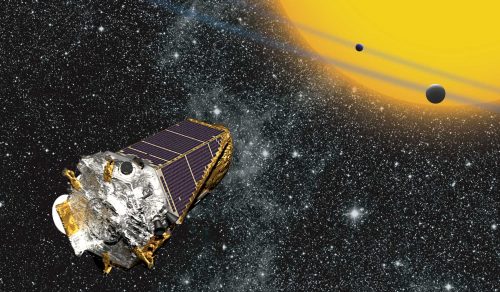Exoplanets capture our imagination, and recent missions have discovered thousands more around neighbouring stars. However, even when discovered, the compositions of exoplanets are difficult to study because of the sheer distance away from us. A recent paper by Harvard University astronomer Li Zeng and his team challenges the conventional belief that many intermediate-sized exoplanets—between one and four Earth radii—are gas dwarfs. Instead, they suggest many such exoplanets are watery worlds, migrating towards their central stars over time and hinting at the prevalence of water in the universe.
Li’s team started by considering a data set of over four thousand confirmed or candidate exoplanets measured by NASA’s Kepler space telescope mission and refined by the European Space Agency’s Gaia astrometry mission. While larger exoplanets generally have greater mass, Li and his team studied a gap in the data between 1.8 to 2 Earth radii; exoplanets detected generally cluster either below this range (rocky worlds called super-Earths) or above (lower density worlds called sub-Neptunes). Previously, most scientists thought sub-Neptunes had to be dwarf gases, since ice could not coalesce during planetary formation at such close distances to the star. The role of this temperature boundary—termed the “snowline”—is key to the model Li’s team proposes.
Li’s team modelled the dynamics of exoplanet formation using equations of state, generating different results by considering various starting conditions. For instance, an exoplanet may or may not have an atmosphere, depending on whether the core contains metals like magnesium silicates versus iron. This includes how water behaves in the high-pressure core. From these simulations, Li’s team concluded that many observed exoplanets within the two to four Earth radii range should have over one quarter of their mass as water. In contrast, the Earth, despite water covering over seventy percent of the globe, is only 0.05 percent water by mass.
If watery, how did these sub-Neptune exoplanets appear within the snowline? The paper’s simulations would suggest the icy sub-Neptune exoplanets formed beyond the snowline, but migrated inwards over time driven by collisions between planets. While rocky proto-planets would likely not survive collisions between one another, icy bodies may instead merge and continue their advance. So, icy planets would get bigger and bigger as they approach the central star, generating a peak in the exoplanet mass data. Such a theory could explain the gap in exoplanet radii/mass observed.
Our solar system, with Earth as the only planet harboring much surface liquid, may not be so typical after all. “Generally speaking, this type of planetary system architecture with close-in rocky super-Earths and water-rich sub-Neptunes may be found more common than in our own solar system, in the Milky Way galaxy,” Li explained. Since all life on Earth as we understand developed dependent on water, astronomers today regard the discovery of liquid water as a crucial pre-requisite to the possibility of life. This approach guides modern scientific exploration of our solar system.
Debora Fischer, an astronomer from Yale University, commented, “I think this work is very interesting and Li Zeng is carrying out exciting simulations to better understand the composition of exoplanets. The one caveat is that there may be uncertainties in the measurements of planet radius and mass that exceed our estimates,” Fischer said. Conventionally, astronomers find exoplanets by detecting faint changes in star light, either as a result of a direct transit, the planet blocking the star, or radial velocity shifts, frequency changes via the Doppler effect. Yet all along the central star fluctuates in brightness, adding noise to the data.
There are other potential concerns with the conclusions drawn in this paper. “The implicit assumption is that the long-term energy budgets of the planets depend strictly on the amount of energy they get from their parent stars,” said Yale astronomer Gregory Laughlin. In particular, “tidal heating, somewhat analogous to that observed on Jupiter’s Moon Io, where intense volcanism is driven by tidal heating” may question the abundance of water worlds, according to Laughlin.
Nonetheless, Li is optimistic that next-generation telescopes can deliver even more accurate mass and orbital radial measurements for stronger simulations. NASA’s follow-up to Kepler, the Transiting Exoplanet Survey Satellite (TESS), will discover more super-Earth range exoplanets. If those masses can be more accurately determined with ground-based spectrographs, researchers will have stronger confidence in the conclusion that watery worlds truly flourish in our galaxy.

